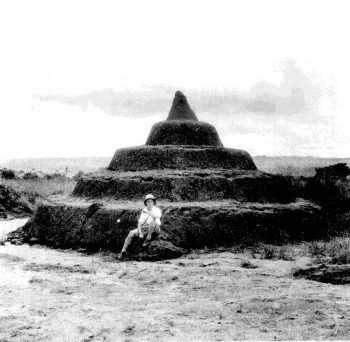Sometime in November, 2018, on a certain Saturday evening, I was listening to Nnamdi Kanu’s (Leader of IPOB) broadcast on Radio Biafra and while he was talking on the Igbo-Jewish heritage, he made mention of the ancient Igbo pyramids located at Nsude, Udi Local Government Area, Enugu State. He claimed the pyramids were parts of the knowledge the Israelites acquired from Egypt in ancient times and there is no way Igbos in the olden days would have knowledge of pyramids if they weren’t part of the Israelites in Egypt.
It was my first time of ever hearing that there are pyramids in any part of Igboland. I contacted my friend who is from Enugu State and asked if he knew where Nsude is? He said yes and that he’s also from Udi Local Government Area. But when I asked him about the pyramids, he wasn’t aware too. So I turned to Google. Below is what I found
In 1935, G. I. Jones, an anthropologist and colonial administrator took pictures of the Nsude pyramids, ancient Igbo pyramids, in Udi, Enugu state Nigeria with a Roloflex camera which he acquired and developed a system for immediate developing which produced negatives of such high quality that they continue to produce excellent prints six decades later. It was at this time that he built up the extraordinary photographic record of Southeastern Nigerian culture.
The pyramids, numbering 10 in number are circular and stepped and were made of clay.
Here are pictures of the pyramids:
G.I. Jones posing in front of a pyramid
The first base section was 60 ft. in circumference and 3 ft. in height. The next stack was 45 ft. in circumference. Circular stacks continued, till it reached the top. The structures were temples for the god Ala/Uto, who was believed to reside at the top. A stick was placed at the top to represent the god’s residence. The structures were laid in groups of five parallel to each other. Because it was built of clay/mud like the Deffufa of Nubia, time has taken its toll requiring periodic reconstruction.
Strikingly, these pyramids bear striking resemblance to the Step Pyramid of Saqqara, in Egypt constructed in 2648 BC and without a doubt, derive from the same cultural/religious/philosophical tradition that inspired this ancient Egyptian monument. Moreso, more striking is the similar replication of Nubian-like pyramids thousands of miles away from the Nubian area in the heart of Igboland, or vice versa, whichever comes first.
The Step Pyramids of Saqqara, Egypt
From another source, I got the following explanations to the pyramids
Circular Stepped Pyramids at Nsude, Northern Igboland
In the neighbourhood of Ngwo, Nsude and Agbaja [Ọ]wa in the Udi Division, at intervals, the people construct quaint circular pyramids. Clay is used for the purpose. The bases are about sixty feet in circumference and two to three feet in height. Then another section is laid about forty-five feet in circumference and so on until the pinnacle is reached. They are erected to the honour of Ala and to indicate ownership of land.
Two rows of five are built parallel to one another which means that “Ala’’ gives children with the right hand and the left. The god (or goddess) dwells in the pinnacle and, thus, is in a position to detect any person committing evil. Such a person will be caught by the god and secured with shackles; these are represented by small sticks inserted in the clay near the tops of the pyramids.
[There were other pyramids, sometimes larger, in other areas of Igboland such as around the Abam]
I understand the pyramids have deteriorated now probably due to emergence of Christianity since it seems to be a sort of shrine then. Personally, I believed the pyramids should be reconstructed as a historical structure. The sooner we Igbos start returning to our roots, the better for us. I am not advocating for return to Idolatry… NO! However if our Idols of old are today in British museums; what will it cause us to starting rebuilding and preserving our ancient artifacts and historical structures?




